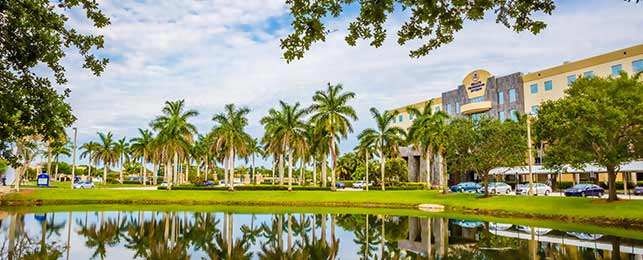
History
University History
Sustained growth and unity has made Nova Southeastern University (NSU) the largest independent university in the state of Florida. This growth culminated in January, 1994, when Nova University and Southeastern University of the Health Sciences merged to become Nova Southeastern University.
Nova University was chartered in 1964 as a graduate institution in the physical and social sciences. Over time, Nova added programs in law, education, business, psychology, computer science, oceanography, social and systemic studies, and hospitality, and, in 1972, introduced its first off-campus course of study, in education. Soon, Nova became nationally recognized for its innovative distance learning programs. Today, field-based programs are located in 32 other Florida cities, in more than 21 other states, and at selected international sites.
While Nova continued to expand its educational reach, Southeastern University of the Health Sciences also was on an expansion course. Southeastern was created by osteopathic physicians committed to establishing a College of Osteopathic Medicine in the Southeast. As a result, Southeastern College of Osteopathic Medicine, as it was first known, opened in 1981.
During a ten year span that followed (1987-1997), Southeastern added Colleges of Pharmacy, Optometry, Allied Health, Medical Sciences, and the College of Dental Medicine which admitted 88 students in 1997. This growth was unprecedented, but not unsurpassed. There was still more to come.
The merger brought on new possibilities. Prior to 1994, Nova had evolved with innovative technology and Southeastern expanded to provide much needed health care education. With the merger, Nova Southeastern University's resources make possible a more transdisciplinary education. Students have an opportunity to integrate across the disciplines and understand how their professions relate to society as a whole.
Campus
Nova Southeastern University's Health Professions Division offers a rare blend of tropical South Florida weather, plentiful sunny beaches, an easily accessible campus, a dedicated and professional faculty, well established affiliations with many hospitals, clinics, and health care systems in the area, and a mission to educate professionals capable of providing the highest quality health care service.
The university's main campus is located on a lush 314-acre site in Fort Lauderdale, 10 miles inland of the Atlantic Ocean and readily accessible via several highways and Florida's Turnpike.
The Health Professions Division complex, dedicated in June, 1996, is located on 21 acres and encompasses over 900,000 square feet of buildings. The Division comprises the Colleges of Osteopathic Medicine, Pharmacy, Optometry, Health Care Sciences, Nursing, Medical Sciences, and Dental Medicine.
The division elicited input from students and faculty and incorporated innovations in architecture, ergonomics, and computer-aided technology to provide facilities that enhance the learning experience.
The complex is an arrangement of eight buildings, four of which are connected by air conditioned lobbies. The Health Center, physical plant, and 1600-space garage are connected to the central buildings by covered walkways. Administration and faculty offices are on the upper levels of the five-story administration building, with the Departments of Admissions and Student Affairs, and a cafeteria located on the first floor.
Behind the Administration Building is the Assembly Building, which consists of a 500-seat auditorium, a 250-seat auditorium, and eight 126-seat amphitheater-classrooms, all equipped with computerized audio/video systems.
Connected to this is the three-story Library/Laboratory Building. On the first floor is the Library and a 100-seat Cardiac Laboratory utilizing "Harvey," a computerized mannequin which duplicates the sounds and symptoms of most heart conditions.
Also on the first floor are patient simulation training rooms and a 50-station computer laboratory for student use. The second and third floors house laboratories, a student lounge, and a research area. Laboratories are equipped for viewing pre-taped medical procedures, and each large laboratory has a video system and hookups to equipment such as an electron microscope, so that illustrations can be amplified for laboratory-wide viewing.
Just north of the Library/Laboratory Building is the Health Care Center, with facilities for primary health care, rehabilitative services, eye care, and a pharmacy. The College of Dental Medicine's 70,500-square-foot building advances the state-of-the-art in dental education facilities. The first floor contains a 100-operatory predoctoral clinic facility and clinics and support laboratories for Oral Medicine, Radiology and Oral Surgery. The second floor houses a faculty practice and clinics for postgraduate programs in Endodontics, Orthodontics, Pediatric Dentistry, and Periodontics, a 100-position simulation technique laboratory and support laboratories. Faculty offices and an auditorium are on the third floor.
The Health Professions Division has added a building to foster opportunities for interdisciplinary education and to meet the need for additional classroom, computer and research facilities. This modern, spacious facility contains over 31,000 square feet of new instructional and research facilities, including a 312-seat auditorium, a 50 station state-of-the-art computer science laboratory and 37 seminar rooms.